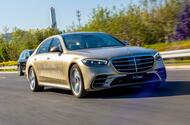We take on Beijing in a self-driving S-Class, watching it take on busy intersections, lane-changes and U-turns
Autocar has been able to sample Mercedes-Benz’s yet to be named autonomous driving tech at the German car maker’s Beijing research centre, with a drive in one of a fleet of S-Class prototypes.
The first thing you notice is the extra digital display, which maps all road users in the car’s vicinity, from pedestrians to trucks. For the tech itself, simplicity is the name of the game.
After selecting a destination via the navigation system, the autonomous mode can be triggered via a steering wheel button once you have set off manually.
On our drive, the car heads on to a busy four-lane arterial road in the south of the Chinese capital, accelerating up to the limited 60kph (37mph) and changing lanes without any prompting from the driver.
After a mile or so, we encounter the first traffic light, at which the car comes to a halt in the far left-hand lane. This positioning is important.
When the traffic light turns green, we creep forward until we reach a major intersection. The prototype halts again as it begins to sense vehicles travelling in the opposite direction.
When that traffic is halted by a red light, the prototype begins to again follow the route, performing a U-turn.
“The U-turn function is one of the most difficult to program,†says Mercedes-Benz’s chief software officer, Magnus Östberg. “Not a lot of companies have the competency to offer this.â€
Bugs were found, of course. On occasion, the system would suddenly apply the brakes when other cars swerved in and out of lanes. It also proved slow to respond to opportunities when the traffic cleared, clearly prioritising safety over road position.
“We’re putting the final touches to the software,†said Östberg. “There is some calibration work to come.â€
Nevertheless, the 30-minute prototype drive, in the midst of Beijing’s rush hour, proved Mercedes-Benz is close to realising its goal. When will it come to Europe? Mercedes said that’s in the hands of the politicians.

